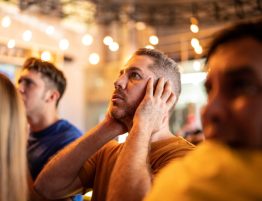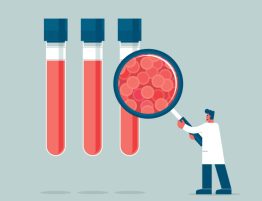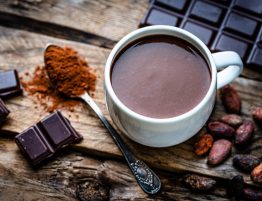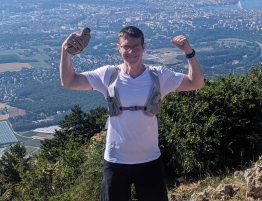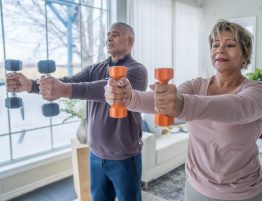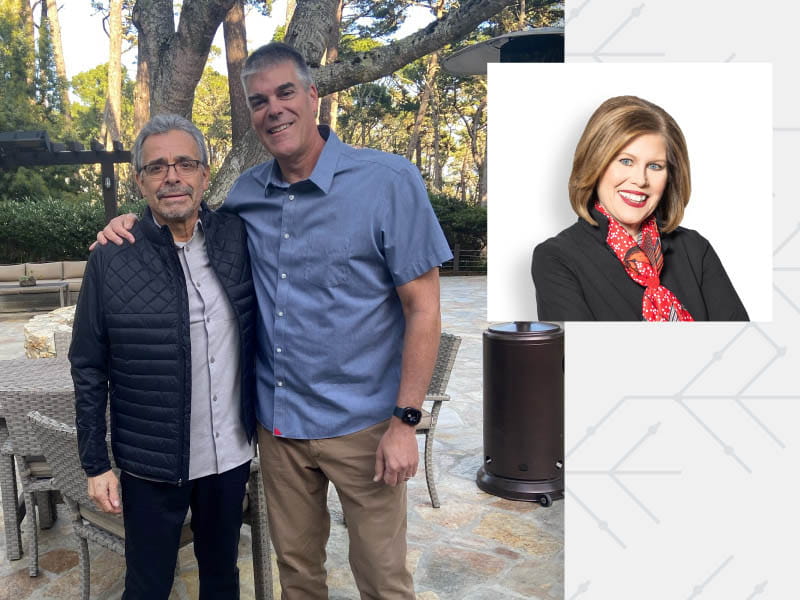
Michael and Danuta Heilemann were approaching the 3-mile mark of the Monterey Bay Half Marathon when they heard the siren. The noise kept getting louder, so they knew it was headed their way.
The Heilemanns were still running when they saw an ambulance pull over ahead of them. Then they saw the reason paramedics were needed. A runner was on the ground, receiving CPR from several people.
As they kept running, Michael said to Danuta, “Wow. It was probably like that for my dad.”
In 1997, Bob Heilemann was in the final 200 yards of a 5K race when he went into cardiac arrest. Bystanders gave him CPR, saving his life.
On this day, the runner the Heilemanns saw in distress – Greg Gonzales – also was saved on the course by bystanders giving him CPR.
And, two hours later, steps after Michael crossed the finish line, it happened to him as well.
It’s a lot to absorb: A father and son (Michael and Bob) both saved by CPR after going into cardiac arrest, each while running a race. Two runners (Michael and Greg) both saved by CPR after going into cardiac arrest during the same race. Yet there’s still another amazing layer to what happened in Monterey. Michael and Greg both received CPR from the same bystander, a runner named Steven Lome, who also happens to be a cardiologist.
The main takeaway from these tales is clear: CPR saves lives. Hopefully their stories will inspire more people to learn CPR. It’s a message that my organization, the American Heart Association, is particularly emphasizing this February, which is American Heart Month.
Stepping back a bit, there’s another message that connects the stories of each of these seemingly healthy men whose hearts suddenly stopped. It’s the hard truth that while heart disease is mostly preventable, we can’t control everything – particularly not what’s lurking in our genes.
***
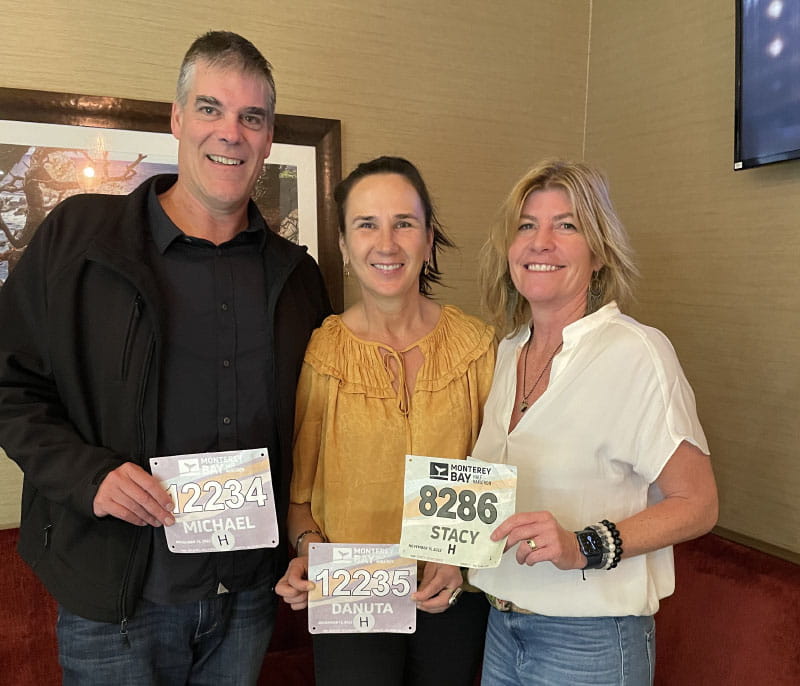
In 1994, Michael was interested in taking on the Ironman triathlon. But he wasn’t sure he could handle the 26.2-mile run. To find out, he entered the Los Angeles Marathon.
In mile 18, he started chatting with another runner. A woman named Danuta.
They married nine months later.
Ever since, they’ve remained active, especially hiking and mountain biking. Running, too, of course.
For many years, Michael and Danuta joined Bob in running a race in Pacific Palisades, California, on Fourth of July weekend. In 1997, the trio ran the first mile or so together, then Bob veered to the 5K finish line while Michael and Danuta continued the 10K route. That’s why they didn’t witness Bob’s cardiac arrest and the CPR that saved him.
Bob was 54. His cardiac arrest was caused by a heart attack; he had blocked coronary arteries. Fixing it required bypass surgery, in part because of a congenital heart defect that complicated his treatment. He later had a valve replaced and received several stents. He also dealt with an enlarged heart before dying a few years ago.
Still, the CPR that Bob received, as well as all other interventions, extended his life by 22 years.
***
Because of his family history, Michael makes sure to get an annual checkup. His latest came a month before the Monterey Bay Half. Everything looked great. At 56, he was already older than his dad was at the time of his heart problem.
But Michael was making one concession to age. He was giving up long-distance races.
Until the COVID-19 pandemic, Michael, Danuta and their friend Stacy Newcomer regularly ran races together. Once in-person events restarted, the trio decided that enough was enough. Except, they wanted to go out in style. They picked Monterey – about a three-hour drive from the Heilemanns’ home in San Anselmo, California – because of how much they enjoyed the scenery while running it in 2013.
Michael and Danuta worked their way up to 10-mile training runs. A month before the race, they squeezed in a 7-miler during a trip to Italy.
On race day, Michael – wearing the red shirt he received at the 2013 race – kept pace with Danuta and Stacy until about mile 9. He slowed, walking briefly during the final 2 miles. He finished about four minutes after the women.
Danuta and Stacy tried waiting near the finish line to greet him. Race officials didn’t let them.
In retrospect, that was a good thing.
Danuta avoided seeing all that happened next: Michael crossing the line, feeling dizzy, grabbing a rail, then collapsing, hitting the ground hard enough to bloody his head; Lome starting CPR, someone bringing him an automated external defibrillator, the first shock reviving Michael, Michael trying to get up because he thought he’d fainted.
She eventually caught up to him at the hospital. Like his dad, Michael’s cardiac arrest (an electrical malfunction in the heart causing an irregular heartbeat) was caused by a heart attack (a blockage in one of his arteries). Doctors implanted a stent to clear the blockage, restoring normal blood flow.
The next day, they learned that Michael’s lifesaver was the same guy they’d seen back in mile 3, saving someone else’s life.
They later learned the other guy’s name was Greg Gonzales.
***
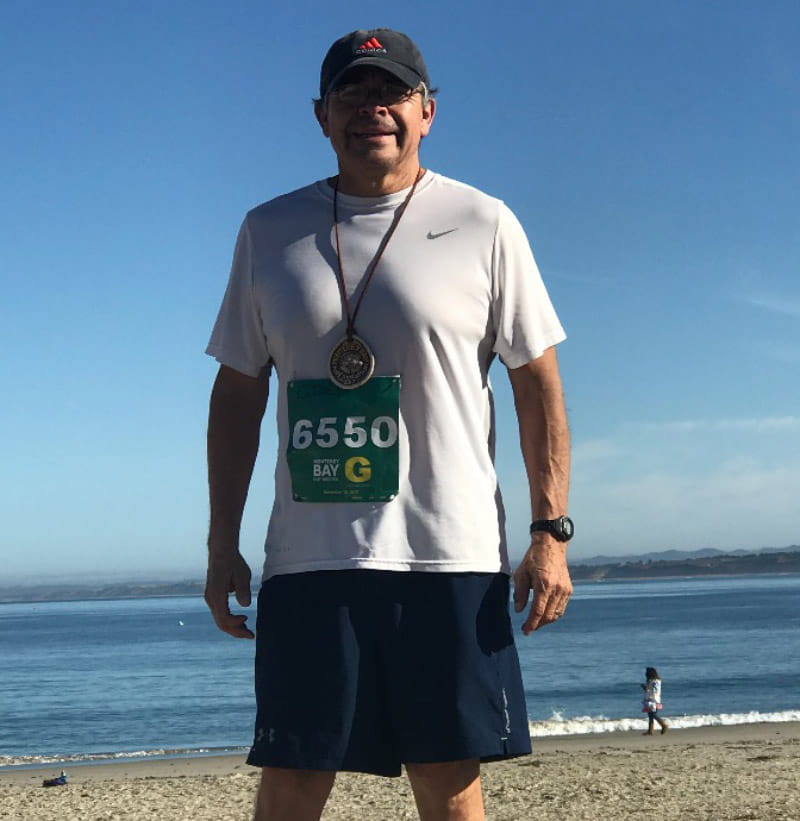
Greg’s dad had a heart attack at 58 and subsequently died from cardiac arrest. His brother was 59 when he had a massive heart attack.
Greg’s longevity plan?
“I was going to outrun my family history,” he said.
He began running in college. In his late 20s, he ran his first marathon. He did 10 before shifting to half marathons. He lives in Vancouver, Washington, but likes the Monterey event, also for the view. This was his third time running it.
Greg’s longevity plan seemed to be working.
He got through his 50s without incident. Along the way, his cardiologist said his heart looked so good that he should only come back if he had any symptoms. In August, he got an annual checkup from his internist. All looked good.
The doctor’s parting remark: “Be cognizant of your family history.”
***
About six weeks before the Monterey race, Greg finished a long run, then went to lift weights. While he occasionally ran and lifted on the same day, on this occasion, he felt compelled to do so. Something told him his chest needed to be stronger.
He became serious about lifting. Three days a week, he pumped out 144 reps across a variety of maneuvers. A picture of him on race day showed that his chest had become stocky in a good, muscular way. This added fitness was part of the reason Greg thought that – at age 67, after running for 50 years – he was about to set his personal record in the half marathon. He was finally going to finish in under two hours.
The morning of the race, Greg couldn’t get comfortable.
He blamed an old pair of socks, so he went back to his car for a new pair. Upon returning to the starting area, he moved spots about six times. He also drank more than usual, which led to a restroom break in mile 2.
Insignificant as each of those actions may seem, Greg gets choked up talking about them.
“Because all these things,” he said, “put me 30 feet ahead of Dr. Lome at the exact moment I needed him.”
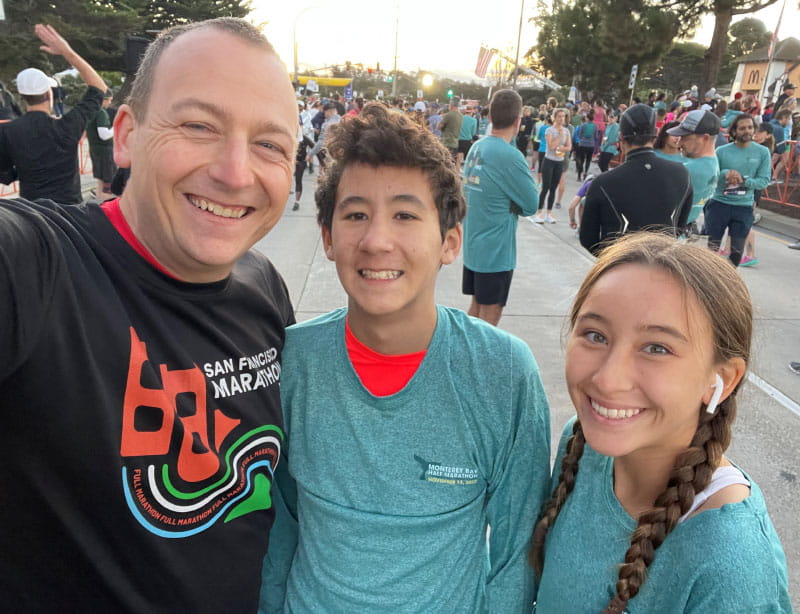
***
Greg was on a downhill toward the Pacific Ocean, taking in the gorgeous view and savoring his pace. The sub-two-hour finish felt like such a sure thing that he began thinking about how he’d celebrate at a restaurant up the coast in Carmel.
The next thing he remembers is waking up somewhere, his chest aching. He realized he was no longer at the race or the restaurant. Then he realized he was in an ambulance.
“You may have had a cardiac event,” a paramedic said.
“MAY HAVE?” Greg said.
“We’re pretty certain,” the paramedic said.
Lome was among three bystanders who’d given Greg CPR for several minutes until an AED arrived. A single shock restored a sustainable rhythm. He, too, had a cardiac arrest triggered by a heart attack. He, too, received a single stent.
***
Lome visited Greg and Michael at the hospital the next day.
In each conversation, they talked about the save, of course. They also talked about Lome’s favorite subject: preventing heart disease.
What happened to Greg and Michael was mostly bad luck. They couldn’t outrun their genes. However, because they’d been so active, their fitness helped them survive. It would also help their recovery.
The other part of a heart-healthy lifestyle is a heart-healthy diet. Greg and Michael both told Lome they could clean up their diet. Lome encouraged them by sharing his own story.
He went from obese and inactive to a two-time marathon runner. Yet he remained above his ideal weight and his LDL (bad) cholesterol was still borderline-high. He tried a plant-based diet. It worked so well that he’s since launched two websites devoted to promoting it. He’s also started Plant-Based Nutrition Movement, a nonprofit with the tagline “Eat plants. Save the world.”
***
Michael and Greg received their second chance at life on Nov. 13, 2022. Add in all the other similarities and it’s easy to see why they joke that they’re now twins.
Their new similarities include following a plant-based diet.
Michael hasn’t gone 100% plant-based, but close. Danuta, too.
“We said, `Let’s give it a shot and see what happens,'” Michael said. “And it has worked better than we expected it would.”
Greg gave up beef, chicken and pork after Thanksgiving. The rapid change left him low on protein and iron, so he’s worked with his doctors to make sure he’s getting the nutrients he needs. He’s now eating a lot more fruit and nuts.
The guys regularly text each other encouragement and recipes. They recently had a lively exchange about nut butters.
“At the end of long runs, I used to tell myself I earned a chai tea and a baked good. Not anymore,” Greg said. “I’ve given up cheese, sour cream, chips and sweets. I’m a sugar hound, but the last cookie I had was before Christmas.”
Both are also rebuilding their activity levels.
Michael – who oversees development of video game tools and technology – has done several 4-mile runs, plus some cycling and has taken part in strength classes that Danuta teaches at their local gym. While he closely monitors his heart rate, he also left the Monterey hospital with an implantable cardioverter defibrillator, or ICD, a machine that can shock his heart back into a normal rhythm should it become irregular again. Recently, he received four more stents, so he’s again rebuilding his endurance.
Greg – a superior court judge for his county, currently hearing cases in family court – has been going to cardiac rehabilitation three times a week and has taken many long walks. He’s hoping to soon receive the green light to run.
The “twins” have a great incentive to get moving. In November, they’re running the Monterey Bay Half Marathon again, along with Lome.
For Michael, it’s a chance to cap his career on a better note. For Greg, it’s a chance to simply finish.
“Trust me, I’m not seeking any personal best this time,” he said, laughing.
They also have another incentive to stick with a heart-healthy lifestyle. It’s perhaps the most important and the most obvious.
***
Greg has three sons in their 30s, a 2-year-old grandson and another grandson less than a year old.
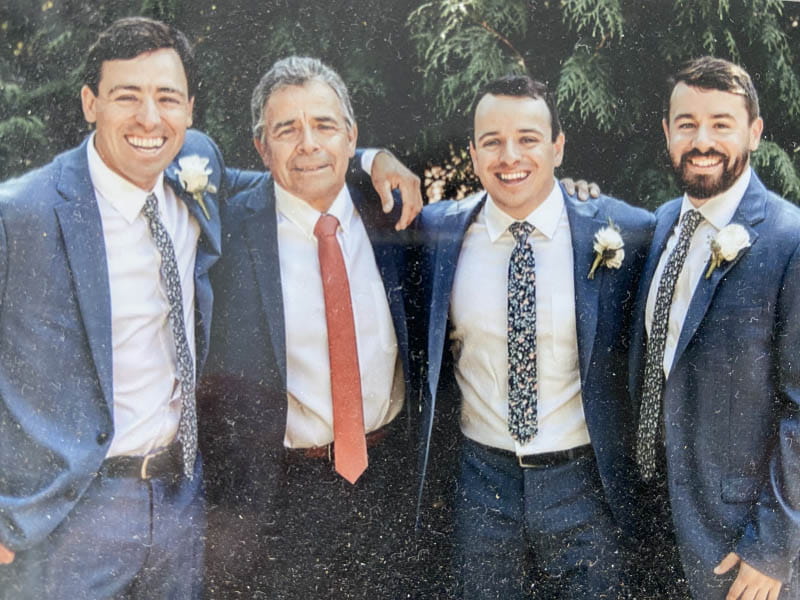
Michael has a son who is 20.
All are now fully aware of their family history of heart disease.
They know they can’t outrun it or eat their way around it. They also know that a heart-healthy lifestyle can help prevent it and can make a difference should they develop heart disease.
Michael’s son has joined him and Danuta in adopting a plant-based lifestyle. He’s in college, and one of his roommates follows a vegan diet, so “it’s been an easy transition for him,” Michael said. “They just buy twice as much when they go grocery shopping.”

Greg’s sons are watching their diet, too. The whole Gonzales brood – including two wives and a girlfriend – are planning on running the race in November.
While Greg and Michael no longer care about running times, there is another numerical goal worth targeting: The number of years they can rack up on their second chance at life.
Remember, Michael’s dad lived 22 years post-cardiac arrest, and Greg’s brother is 14 years and counting beyond his heart attack.
“My to-do list each day is down to one thing: Live. Live, live, live,” Greg said. “It’s kind of a simpleton approach, but it’s working. I just don’t want to lose my boys. I don’t want to be away from them. I felt like that before my cardiac arrest, but more so after, no doubt. I have to live longer.”
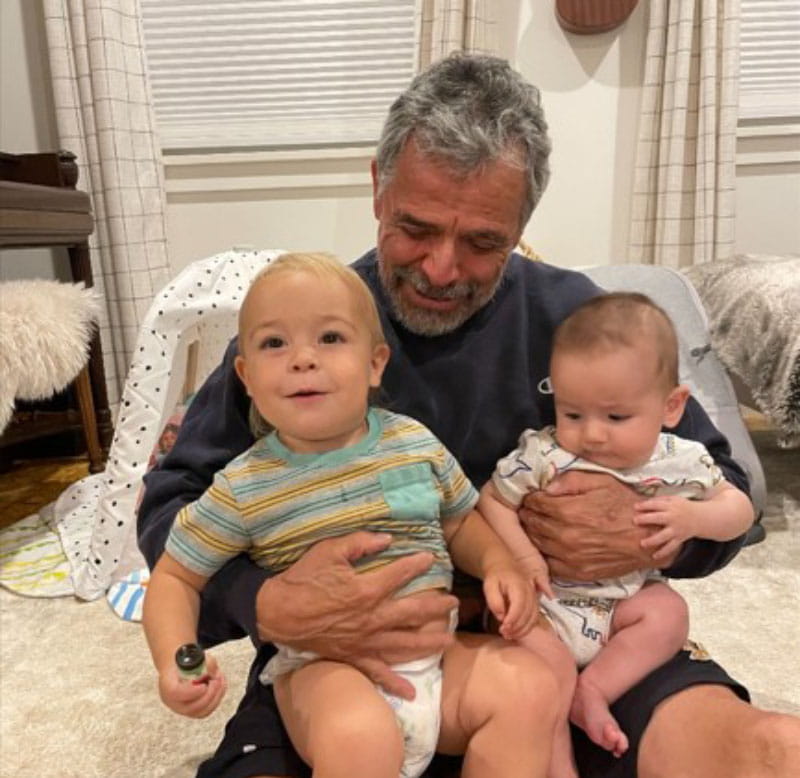
A version of this story appeared on Thrive Global.
If you have questions or comments about this American Heart Association News story, please email [email protected].

